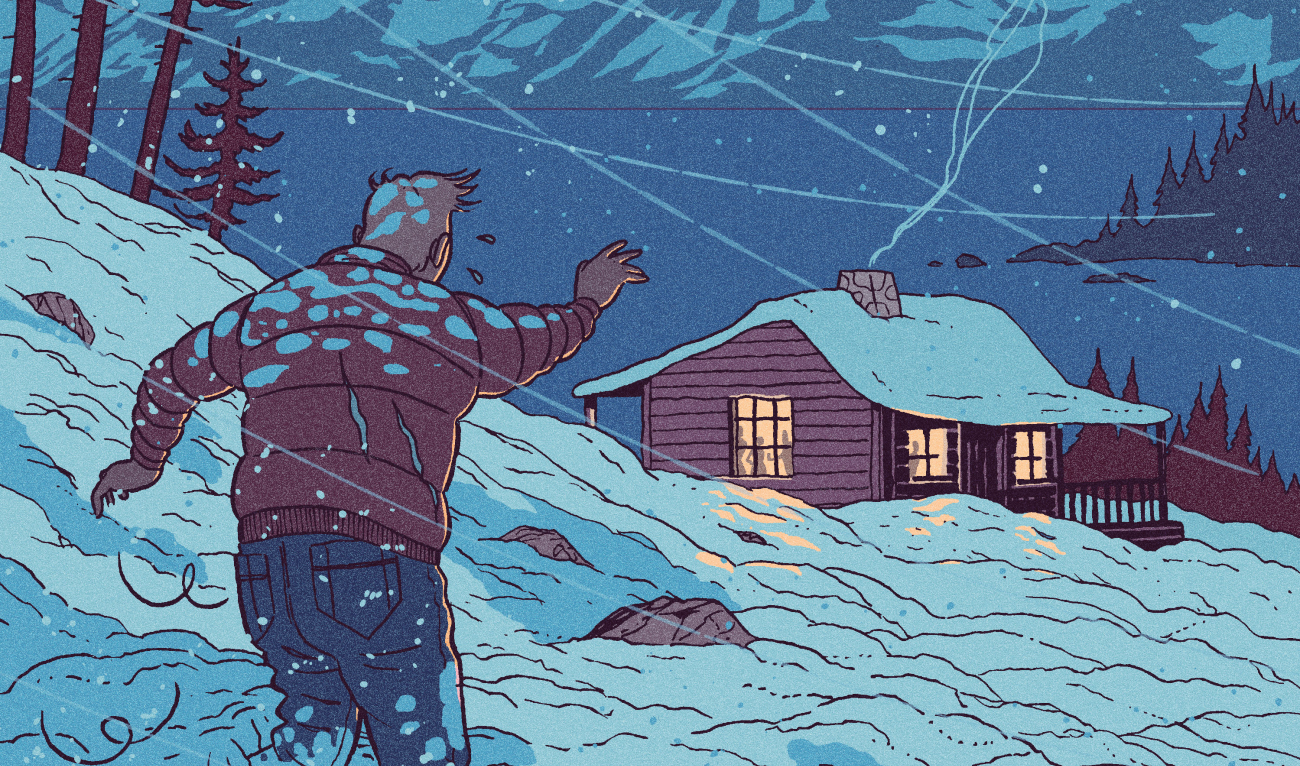Avalanche
The skies over the Sierra Nevada opened on February 6, 1999. Nearly two feet of snow fell that Saturday, and winds gusted at 60 miles per hour. “It was pounding that afternoon and continued to pound through the evening and into the night,” recalls Chris Seldin ’93. As conditions worsened, so did the threat of an avalanche.
Seldin and 16 others—six alumni and their friends—were spending a ski weekend at a cabin owned by the Dartmouth Outing Club of Northern California. It stands on the shore of Tahoe’s Lake Mary at an altitude of 7,000 feet, about a mile from Sugar Bowl Ski Resort—and not far from where the ill-fated Donner Party of 1846 met its demise.
As bedtime approached, the skiers settled in with full bellies, dishes done, and logs crackling in the fireplace. Then, a knock on the window.
Another knock. Then another, and a figure in the window, shouting and gesturing wildly.
“At first I thought it was a joke,” says Seldin. Could it be more friends? Late arrivals?
The figure banged on the glass until it broke. A young man no one recognized appeared. “I saw the urgency in his face,” Seldin recalls. The frantic visitor was Harry Eichelberger, a college student, who explained that several hours earlier he and three friends had been buried by an avalanche. Eichelberger had briefly talked to one of his companions while they were buried, then started eating snow to free his teeth. He bit off his gloves and scraped his way to the surface. With hands too swollen and cold to uncover his friends, he staggered through the storm toward the light of the cabin’s window.
His friends remained buried in snow across the lake.
Everyone inside the cabin sprang into action. “It felt like we had an incident commander,” recalls Katie Fesus Zanto ’94, “even though we didn’t.” Many had backcountry skiing experience and some familiarity with avalanches. Zanto and former DOC president Jamie Rosen ’92 were mountaineering instructors for Colorado Outward Bound.
One group grabbed jackets and hurried to retrace Eichelberger’s footsteps to the avalanche site before his path disappeared in the blizzard. Another group headed to the nearby Alpine Skills International (ASI) center for help. Others gathered sleeping bags and blankets and started boiling water. Susy Struble ’93 called emergency services from the cabin phone, trying, as she recounts, “to get them to believe what we were telling them.”
Seldin and others grabbed rakes, brooms, mops, and shovels. As the snow fell hard and heavy, they skied with headlamps across the lake to the avalanche site. Seldin saw a gloved hand sticking out from the snow. They started digging and pulled out one victim, Derek Lerch, and led him back to the cabin.
The rescuers kept probing the snow. After Seldin’s broom handle hit something soft, he and Zanto shoveled out Marisa Nelson, who lay face down, buried atop a slushy layer at the lake’s surface. When they pulled her out, Nelson’s eyes were open, but she was unconscious. The rescuers wrapped her in a sleeping bag, and talked to her, trying to keep her stable.
Nearby, other rescuers had uncovered another victim, Malcolm Hart. Zanto spoke to him. Hart was responsive and breathing, but fluid gurgled in his mouth. As Zanto wondered if she should do CPR or mouth-to-mouth, an ASI volunteer arrived. “We can’t tell—we think he just stopped breathing,” Zanto told the volunteer, who attempted to provide aid.
Firefighters and first responders appeared on the scene. They loaded Hart onto the back of a snowmobile. Rosen climbed on and performed CPR chest compressions on Hart. The sled, huffing through the deep snow en route to the road, bucked Rosen off. He clambered back on and continued CPR. “I was just doing it,” he says. “I was trying to help as best I could in the moment.”
At the hospital, after several hours of attempted resuscitation, Hart died. He was 21. Nelson, who also was transported out of the accident site by snowmobile and treated at the hospital, survived without any serious injuries, as did Eichelberger and Lerch.
“We saved three lives last night,” begins the sober entry Eddie Gilmartin ’91 wrote in the cabin’s logbook on February 7, 1999. “A phenomenal day of skiing turned to tragedy, but tragedy…was averted for at least three.” By the time the storm ended on February 9, the ski resort was cloaked in 14 feet of snow. On February 21, 1999, the Donner Summit Fire Department awarded a certificate of merit to the DOC for “Community Service and Valor Above and Beyond the Call of Duty in the Lake Mary Avalanche.”
The cabin remains a big part of Struble’s life, and she often visits with her family. “I always try to spend a few minutes alone on Lake Mary, looking across to where it happened, and send love to Malcolm and all involved,” says Struble, who works in the tech industry and lives in Piedmont, California.
Zanto is now a senior lecturer at the University of Nevada, Reno, at Lake Tahoe, and Rosen is a lawyer for the U.S. Forest Service.
For Seldin, a district court judge in Aspen, Colorado, the memories arrive in a gesture by the mother of one of the survivors, who sends a card each year. “She commemorates the rescue’s anniversary with a family photo and some words documenting the growth of the lives we saved,” Seldin says. “I’m grateful she reminds us of it.”
CHARLIE PIKE, a former DAM intern, is a freelance writer in San Francisco.











